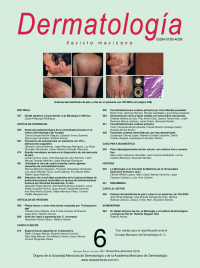Resumen
ANTECEDENTES: las onicomicosis son infecciones fúngicas de las uñas de las manos, los pies o ambos. Entre los grupos con mayor prevalencia destacan los individuos con VIH/SIDA. Estos pacientes tienen importante morbilidad; en términos clínicos las manifestaciones son más agresivas e inusuales y existe mayor probabilidad de resistencia al tratamiento convencional.
OBJETIVO: determinar la frecuencia de onicomicosis en pacientes con alteraciones ungueales y VIH.
MATERIAL Y MÉTODO: estudio transversal, realizado en 250 pacientes con VIH y alteraciones ungueales. Se realizó un cuestionario clínico y epidemiológico. Se seleccionó una uña blanco y se realizó estudio micológico (examen directo con hidróxido de potasio a 20% y cultivos en agar dextrosa de Sabouraud simple y con antibióticos).
RESULTADOS: se obtuvo frecuencia de onicomicosis de 55%, predominó el género masculino en 88%, el grupo etario más frecuente fue de 38 a 47 años (40%). Las uñas de los pies se afectaron en 91%. La onicomicosis subungueal distal fue la más observada con 69%; predominó Trichophyton rubrum en los aislamientos. No encontramos relación estadísticamente significativa entre los CD4 y la onicomicosis.
CONCLUSIONES: encontramos frecuencia de onicomicosis de 55% en pacientes con VIH/SIDA y alteraciones ungueales; en este grupo de enfermos con cambios de las uñas es importante realizar estudio micológico porque pueden ser foco de una probable infección sistémica.
Palabras clave: onicomicosis, frecuencia, VIH, onicomicosis subungueal distal, Trichophyton rubrum
Abstract
BACKGROUND: Onychomycosis are fungal infections of the fingernails and/or feet. Among the groups with the highest prevalence of onychomycosis, individuals with HIV/AIDS highlight. These patients have important morbidity, clinical presentations are more aggressive and unusual and they are more likely to develop resistance to conventional treatment.
OBJECTIVE: To determine the frequency of onychomycosis in patients with HIV and nail disorders.
MATERIAL AND METHOD: A cross-sectional study in 250 patients with HIV and nail changes was carried out. A target nail was selected and it has been made a mycological study (direct examination with potassium hydroxide 20% and cultures in Sabouraud dextrose agar simple and antibiotics) was performed. In addition, a clinical, epidemiological questionnaire was conducted.
RESULTS: A frequency of onychomycosis of 55% was obtained, the male gender predominated in 88%; the most frequent age group was 38 to 47 years (40%). The toenails were affected in 91%. The distal subungual onychomycosis was the most observed with 69%. Trichophyton rubrum prevailed in the isolates. We found no statistically significant link between CD4 count and onychomycosis.
CONCLUSIONS: We found a frequency of onychomycosis of 55% in patients with HIV/AIDS and nail changes; in this group of patients with nail changes it is important to do a mycological study, as they may be a likely focus of systemic infection.
Keywords: onychomycosis, frequency, HIV, distal subungual onychomycosis, Trichophyton rubrum

